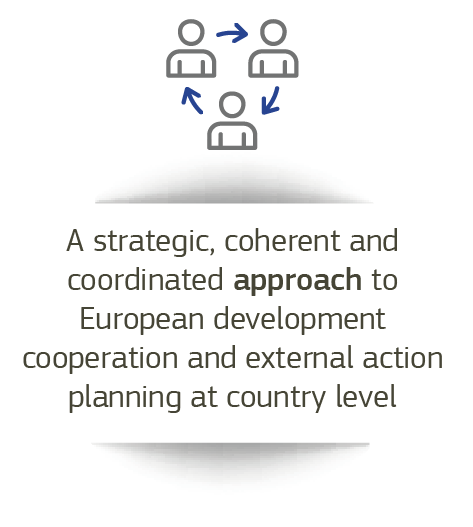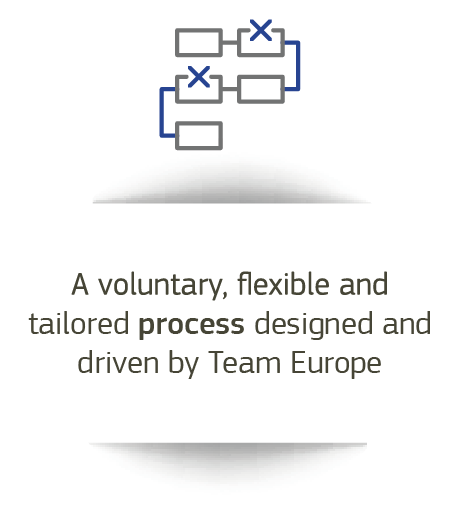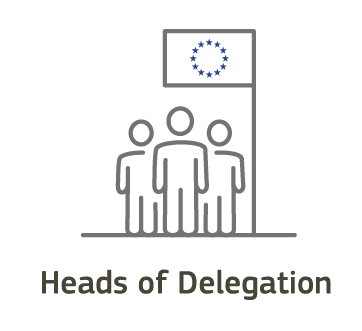4. A quick guide to joint programming
Joint programming is a strategic engagement process by Team Europe and other European partners that starts with a joint analysis of the challenges and opportunities in a partner country and then develops a joint response at country level based on the EU’s values and interests and in support of that country’s national development priorities and associated financing strategy to achieve the SDGs.
What is joint programming?
|
Image

|
Image

|
Image

|
Image

|
- Joint programming allows for a more strategic, coherent and coordinated approach to European development cooperation and external action planning at country level, where Team Europe members work hand-in-hand to promote EU values and interests and to implement the 2030 Agenda and the SDGs.
- Joint programming is a voluntary, flexible and tailored process designed and driven by Team Europe, along with its like-minded partners when relevant, in consultation with partner country counterparts. It can be adapted to different contexts, including countries experiencing conflict and fragility as well as least developed countries.
- Joint programming has to date mainly focused on bringing together the development cooperation provided by the EU and by its Member States to a particular country or region into a Joint Programming Document. However, a joint programming process can also provide a framework to work ‘beyond development’ to address other external action priorities in a partner country, such as human rights, gender equality, security, climate action and trade.
- Joint programming now provides an opportunity for Team Europe to develop collective policy dialogue, speaking with one voice. It also provides visibility at country level to Team Europe.
What does joint programming consist of?
|
Image

|
- Joint programming starts with a joint analysis of a country’s particular situation to identify the needs and issues to be addressed (chapter 9), followed by a joint response (chapter 11) that proposes a collectively agreed strategy.
- A joint results framework then translates the priorities that have been identified into measurable results and impact. Monitoring the joint results framework will serve to inform a dialogue with national stakeholders regarding the contribution of Team Europe assistance, while enhancing mutual accountability.
- The ensuing joint programming document (chapter 12) should reflect the partner country’s national development priorities and will therefore be most successful when synchronised with the country’s national planning cycle.
- A joint programming document provides indicative levels of funding for all participating partners, disaggregated by priority objective/result area.
- Whenever relevant, like-minded partners can participate in a joint programming process at country level, based n their added-value and comparative advantage, following a decision by Member State Heads of Mission.
- Joint programming documents are approved by each participating partner according to their respective internal regulations. A joint programming document can replace participating Team Europe members’ strategies or plans (and those of other like-minded partners, if any).
- Joint programming documents should foresee reviews as a basis for collective dialogue, for shared learning with national stakeholders and as a way to adapt to changing circumstances.
How is a joint programme implemented?
- Joint programming supports Team Europe and — whenever relevant — like-minded donors to think jointly about the implementation of development cooperation and other activities. This reflection should lead to a ‘division of labour’ by priority areas or sectors, a pooling of resources and capacities through specific joint implementation modalities, the conception of joint actions or visibility events, etc.
- Joint implementation (section 3) is the best way to provide coherent, effective and coordinated Team Europe support to specific sectors or priorities at country level. Both financial and non-financial modalities of joint implementation can emerge from a joint programming process.
Who is involved in joint programming from Team Europe?
|
Image

|
Image

|
Image

|
- Heads of Delegation, together with Member State Heads of Mission, lead the process. They play a key role in representing EU interests, values and principles, reconciling them with the partner country context and conducting dialogue with officials from the partner country government.
- Heads of Cooperation manage the joint programming process. The coordinating and facilitating role of the EU Head of Cooperation includes leadership in the process, communication and consensus-building.
- Development and/or political, as well as economic counsellors provide ideas that inform the potential scope of joint programming, prepare inputs from their specific sector and contribute to political, technical and economic coordination.
Is joint programming appropriate in fragile or crisis contexts?
- The 2016 Council conclusions on stepping up joint programming stress the importance of expanding joint programming in fragile situations and conflict-affected countries, as well as in prevention or post-conflict settings. In this context, the Council recalls its conclusions on the EU’s comprehensive approach, noting that the starting point of the comprehensive approach must be an early, coordinated and shared analysis. This provides a strategic basis for conflict-sensitive EU programming (chapter 6).
Each section or chapter may be used separately to fulfil a specific need for guidance, which means there may be some overlap between the different parts of the document.
If you have any questions, you may contact the relevant helpdesk or functional mailbox:
- JOINT-PROGRAMMING-SUPPORT@eeas.europa.eu
- INTPA-JOINT-PROGRAMMING-SUPPORT@ec.europa.eu
- NEAR-JOINT-PROGRAMMING@ec.europa.eu
Recent updates
